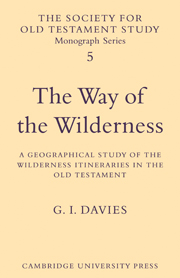Book contents
- Frontmatter
- Contents
- Preface
- Abbreviations
- Maps
- 1 Introduction
- 2 Jewish interpretations in Greek
- 3 Jewish interpretations in Hebrew and Aramaic
- 4 Christian interpretations
- 5 Arabic interpretations
- 6 Behind the traditions
- 7 Key points on the routes
- 8 Routes in the Sinai Peninsula
- 9 Identification of the routes described
- Notes to the text
- Bibliography and Author Index
- Indexes
7 - Key points on the routes
Published online by Cambridge University Press: 04 August 2010
- Frontmatter
- Contents
- Preface
- Abbreviations
- Maps
- 1 Introduction
- 2 Jewish interpretations in Greek
- 3 Jewish interpretations in Hebrew and Aramaic
- 4 Christian interpretations
- 5 Arabic interpretations
- 6 Behind the traditions
- 7 Key points on the routes
- 8 Routes in the Sinai Peninsula
- 9 Identification of the routes described
- Notes to the text
- Bibliography and Author Index
- Indexes
Summary
In the preceding chapter we indicated the attitudes which we propose to adopt to the Biblical text and the traditions of interpretation contained in Jewish, Christian and Arabic sources. In addition we shall be guided by the principles of toponymy as set out by Aharoni. There are however special problems in the interpretation of the itineraries which need to be overcome if the routes described are to be identified with any degree of certainty at all. On the one hand a century and more of exploration has been unable to discover more than a handful of plausible equivalents for names in the itineraries, either in ancient texts or in recent Arabic nomenclature. But on the other hand, where possible survivals of the names do occur, there is often more than one such possibility. Fortunately there are a few places which are mentioned not only in the itineraries but in other parts of the Old Testament as well, so that these can be identified with some confidence and can then serve as indicators of the general outline of the routes described. For example, there is no doubt that the places named in Num. 33: 45b–49 lay on a route running north to a point near the northern end of the Dead Sea. That itinerary therefore has a fixed terminus. Other places whose identification is of programmatic significance are Mount Sinai (or the Wilderness of Sinai), Yam Suf and Kadesh.
- Type
- Chapter
- Information
- The Way of the WildernessA Geographical Study of the Wilderness Itineraries in the Old Testament, pp. 62 - 75Publisher: Cambridge University PressPrint publication year: 1979

